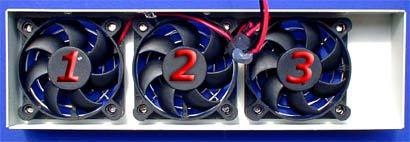Barebones PC Cooling Tower: A Showy Case From Koolance
Conclusions
The assessment for the barebones system from Koolance is fairly harsh: Despite the fact that it is a water cooling system, the cooling efficiency is very poor, with the result that our test configuration quit working after 20 minutes. The reasons for this are as follows: a pump which is far too small, located inside the heat exchanger, only produces a low volumetric flow. Plus the heat sink of the heat exchanger is anything but well designed, with the result that the water is unable to even circulate and thus have a cooling effect. The manufacturer has devoted far too little attention to the three fans, which should in fact produce a higher air flow. In practice, these miniature fans may indeed be quiet, but they can hardly cope with the vast amounts of heat from the heat sink. In addition, the temperature sensor switches on the fans upon reaching 35 degrees - but users are left on their own to decide where to position the sensor. Since no suitable holder for the sensor is provided, there is a risk of a total system failure.
The most critical weak point: The excessively small fans cannot handle the vast quantity of heat.
If you compare the barebones system from Koolance costing up to 250 dollars with the water cooler we constructed ourselves, the outcome clearly speaks in favor of the homemade system. Our system achieves a cooling temperature of 24 degrees - provided that the same requirements apply and that identical hardware is used. Even the best conventional cooler (see cooler comparison: Can't Touch This - A Comparison of 46 CPU Coolers ) from Swiftech (MC 462) achieves a cooling temperature of 30 degrees - and this is with the aid of a large heat sink made from solid copper.
A final word about the Koolance system: the system we tested gives the impression of being a flashy piece of equipment, operating on the principle that lots of technical sophistication coupled with a good visual appearance is enough to coax the buyer. Obviously, there is money to be made selling powerful cooling systems, and the profits must be better compared to numerous other components found in the PC these days.
Our Suggestions To Koolance
It is possible to bring the system up to snuff bit by bit. The first step would be to replace the three miniature fans with larger and more powerful versions. This would produce a high volumetric flow for the heat exchange process. Ultimately, the system only crashes in its present state because the cooling performance is inefficient. In addition, optimizing the shape of the heat sink is also a possibility: More cooling fins closer together enlarge the radiation surface and create the conditions required for better cooling efficiency. The undersized pump should be upgraded to produce a higher delivery rate, which could also boost the cooling efficiency. A further flaw is the positioning of the heat exchanger beneath the PC case, as this causes the entire PC tower to heat up. Finally, the heat sink constitutes a very large radiation surface that quickly heats up the components inside computer.
Get Tom's Hardware's best news and in-depth reviews, straight to your inbox.
